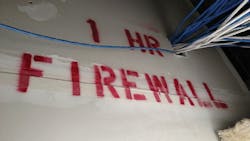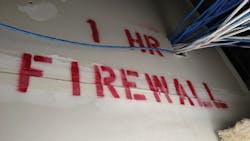Firestopping, the always-important function, gets new tools
Innovative approaches to restoring a wall’s rating and software-based design tools drive firestopping forward.
By Patrick McLaughlin
At the BICSI Winter Conference that will be held in early February—just about the time this magazine hits the streets—firestopping industry veteran Mike Tobias will make a “swan song” presentation prior to his retirement. “It has been a long and winding road,” Tobias, chief executive officer of Unique Firestop Products, told Cabling Installation & Maintenance of his near-40-year career in the cabling and firestopping trades.
Tobias’s presentation is titled “How to make inspectors happy, happy, happy—firestop to code.” He authored a companion document titled “The art of pleasing the AHJ [authority having jurisdiction] when firestopping,” which is posted on Unique Firestop Products’ website. In the document, Tobias observes, “Most inspectors are surprised when a telecom installer even makes an effort to properly firestop cables, much less have a plan in place to do it professionally. You must bid the firestop procedure you select, so do it as an addendum if your competitors will not bid it. Just because firestop is not in the scope of work, it does not mean that it does not have to be done.”
In a presentation about satisfying AHJs—authorities having jurisdiction—Unique Firestop Products’ Mike Tobias displays this photograph from a jobsite with the simple command, “Don’t be this guy.”
One image from Tobias’s BICSI presentation is included in this article. In the presentation, the photo is accompanied by the short-and-blunt caption, “Don’t be this guy.” In his AHJ document, Tobias reminds us, “If firestop is not in the bid or scope of work, make an issue of it and go on record seeking to do it properly.”
Over the 20-plus years it has been in business, Unique Firestop Products has brought to market several product and system innovations that have made it easier and more practical for cabling professionals to return walls to their original fire rating after having been penetrated to allow cables to pass through. They have included split-sleeve, smooth-sleeve, and threaded-sleeve systems, along with membrane firestop systems and others.
Other providers of firestop technologies have brought new innovations to market over the past couple years as well. For example, in 2017 Specified Technologies Inc. (STI) added the EZ-Path Retrofit Device to its EZ-Path portfolio of fire- and smoke-rated cable pathway devices. At the time of the introduction, STI explained the device “can instantly convert existing deficient, overfilled cable sleeves to 100-percent code-compliant sleeves in seconds. By simply clamping onto the end of the steel sleeve, this two-piece device incorporates intumescent technology to expand and close off the path of fire.
The Hilti Button is an automation software package that integrates with building information model (BIM) software platforms.
“The EZ-Path Retrofit Device plays a functional role permitting cables to spill out of the sleeve and travel in any direction—an important function for existing buildings with cables traveling in various directions,” STI added. “Each device is fitted with additional smoke-sealing foam to provide very low L Rating values to minimize smoke leakage, and the devices are able to accommodate bushings snapped or screwed onto the ends of the sleeves.”
Roxtec offers a family of HD (high-density) cable transit devices, which the company describes as “high-density cable entry solutions for terminal boxes and enclosures.” The company explains, “One cut-out for a Roxtec HD kit can accommodate up to 32 armored or non-armored cables, drastically reducing the amount of space required when compared to 32 cable glands. The Roxtec HD is developed to provide environmental protection in the harshest of environments.”
These devices are used in a variety of environments, particularly including marine applications, and for a variety of cable types—including communications as well as power cable.
Innovations in firestopping are not limited to hardware, as Hilti demonstrated when it introduced the Hilti Button for Firestop. The company described the introduction as “the first firestop automation software to integrate with building information model (BIM) software platforms. The Hilti Button automates the firestop product and UL system selection process, and eliminates the tedious, time-consuming and manual task of placing hundreds of firestop objects in BIM.”
The Hilti Button, the company further explained, automatically detects penetrations in fire-related construction and populates the appropriate firestop products and UL systems directly into the BIM to save time, increase efficiency, and reduce costs.
“After the penetrations needing firestop are identified, the Hilti Button automates the firestop product and UL system selection process by identifying an appropriate firestop product and UL system for penetrations based on the attributes in the model. This helps to eliminate the need for plans and codes to be reviewed by firestop experts for specific products and systems on a project. After reviewing and/or updating the firestop product and UL system selection, the user can generate comprehensive submittal documents, create a bill of materials and place direct orders.”
Patrick McLaughlin is our chief editor.


